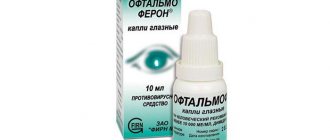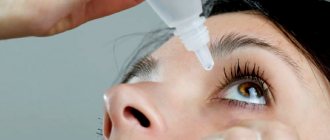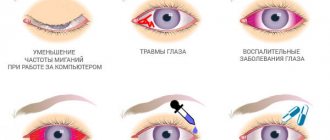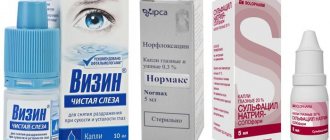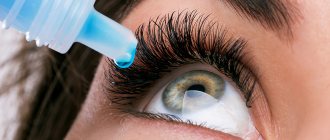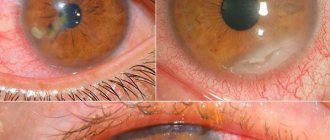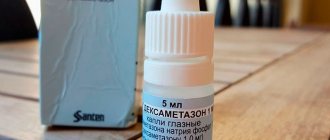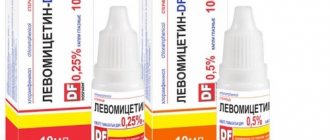Inflammatory process of the eye is quite common in newborns. And new moms and dads need to navigate the main manifestations of this inflammation. This is necessary in order to notice changes in time and quickly seek help from a doctor. It is necessary to eliminate the disease, as they say, at the root, without starting the process, and not suffer from the consequences of late treatment.
Timely examination and adequate treatment of colpitis and sexually transmitted infections in a pregnant woman is the main and necessary prevention of inflammatory eye diseases in a newborn. After all, during a natural birth, a child can become infected with mucous membranes from the microflora of the mother’s birth canal.
In this article, I will introduce you to the main manifestations of the inflammatory process in the eyes of babies, the features of eye hygiene, and will help you understand the many eye drops for newborns.
Manifestations of eye inflammation
It should be clarified that the causes of inflammation of the membranes of the eye can be bacteria, viruses, or an allergic reaction to various foreign agents. An inflammatory process of an allergic nature, as a rule, is not typical for a newborn. It takes enough time and repeated contact with the allergen to develop.
Inflammation caused by bacteria is manifested by redness and swelling of the eyelid, expansion of the vascular network of the white part of the eye, tearing and suppuration. As a result, the pus dries and sticks the eyelashes together. This is accompanied by itching, a feeling of sand or a foreign body in the eye.
This, of course, causes discomfort for the baby, and he will show this by anxiety and capricious behavior. The child will constantly pull his hands towards his eyes and try to rub his eyes. The baby’s eyes especially swell and “swim” with pus after sleep. Often a child cannot open his eyes due to glued eyelashes. It’s simply impossible to look at this calmly.
And in such cases, if it is not possible to immediately see a doctor, parents need to look for information on their own, but not on mommy forums, but on specialized sites where there are recommendations from specialists and clear explanations of what is possible and what is not.
With inflammation of the conjunctiva of the eye of a viral nature, the changes occur almost the same as with a bacterial process. The difference is that the disease is preceded by a viral infection of the upper respiratory tract. From the first days, lacrimation appears, and then pus may appear in the eyes. Everything occurs in combination with swelling of the nasal mucosa, since the nose and eye are connected by the nasolacrimal duct.
Often viral conjunctivitis is complicated by the addition of bacteria to the inflammatory process. This happens due to the fact that viruses seem to disarm the platform, on which any bacteria can then freely land. Only a doctor can tell what process is going on in your child, having previously examined and examined the baby.
Helpful: How dangerous is a hematoma in a newborn?
You need to know all this in order to accidentally, for example, on the advice of a friend, not treat a bacterial process with antiviral drops or vice versa. It is necessary to take a competent approach to the choice of medications and be guided by the principle of “do no harm.”
It is worth noting that dacryocystitis (inflammation of the lacrimal sac) very often occurs in newborns due to blockage of the nasolacrimal duct. As a rule, the cause of this condition is a congenital adhesion (film) in the cavity of the lacrimal canal.
Dacryocystitis itself does not cause the child any anxiety, pain, itching, or visual impairment.
However, the presence of such adhesions leads to stagnation of tears in the baby’s eyes. And if there is no adequate outflow of tear fluid, sooner or later bacterial flora will join. As a result, the eye gets stuck and quite a lot of pus is released.
The gradual expansion of this channel occurs independently until the baby is 3 months old, including due to the natural growth rate of the child.
There is a high probability that the adhesive will break through on its own. If this does not happen, the eyes are constantly swollen, and the treatment gives a short-term effect, then they resort to surgical treatment (probing) of the canal with a special probe.
The best way to avoid probing the nasolacrimal duct is to regularly massage the lacrimal sac. The purpose of the massage is to increase the pressure in the canal in order to break through the adhesions and allow the outflow of tear fluid.
Indications for the use of eye drops for children
The younger the baby is, the softer the composition of the drops he should choose. Also, the product should be hypoallergenic and have as few side effects as possible.
For inflammatory processes, the ophthalmologist prescribes eye drops for children. As a rule, if a child’s eyes fester, swelling occurs, this indicates the presence of an infectious disease:
READ ALSO: How to treat if a child’s eyes fester at 3 years old?
- adenoviral infection (we recommend reading: effective treatment of adenoviral infection in children),
- pneumococcal, staphylococcal, herpes infection,
- measles,
- diphtheria,
- in some cases, the cause is allergies to pollen, dust, deodorants or medications.
How to wash a newborn's eyes
Furacilin is more often used to wash the eyes than chamomile decoction and brewed tea. And this is correct, since furatsilin is an antimicrobial agent. Furacilin is available in the form of an aqueous solution and in tablets, which parents need to dissolve themselves.
The tablets take quite a long time to dissolve. It is better to grind them first. This will save you time. Concentration of the solution: one tablet of furatsilin is needed per 100 ml of warm (37°C) boiled water.
Be sure to wash your hands with soap and water before rinsing your eyes. Moisten a sterile cotton swab with furatsilin so that the solution does not drip from it. Rub the eye from the outer edge of the eye towards the nose, slightly moving the lower eyelid.
Use a new swab for each eye. You should wash your eyes 3-4 times a day.
If there is too much discharge from the tear duct, you have to wipe the eye frequently, but the effect is still short-lived, then you need to squeeze out the accumulated contents from the tear duct before rinsing.
To do this, you need to apply light pressure several times along the edge of the bridge of the nose towards the eye (from bottom to top). The procedure, of course, is incomprehensible and not very pleasant for the child, but the eye will remain clean longer.
Useful: How to assess the condition of a newborn using the Apgar scale: algorithm, interpretation, table, conclusions
Albucid eye drops for newborns
Doctors may often prescribe Albucid eye drops, also called sulfacetamide, for newborns. These drops are intended for use only for eye diseases. Newborns are recommended to use the product in a 20% solution of sodium sulfacyl and water.
Albucid eye drops for newborns have an antibacterial effect. They are used only locally, and they are capable of penetrating into all parts of the eye, sometimes the drug is absorbed into the systemic bloodstream. If too much Albucid eye drops enter the bloodstream, some side effects may occur. Therefore, the drug should be used strictly as prescribed by the doctor.
Albucid eye drops for newborns can be used from the first days of life. Thanks to their use, the course of infectious processes in newborns is prevented, the reproduction of pathogenic bacteria in cells is prevented, as a result of which the process of disease development is inhibited.
How to use eye drops correctly:
- Wash your hands with soap.
- Open the bottle so that the dropper tip does not touch anything. Otherwise, the solution will become contaminated.
- Secure the child's head. You can swaddle him.
- Hold the bottle upside down in one hand, and with the other hand, open the child’s eye, pulling the lower eyelid further.
- Hold the dropper close to the eye, without touching it, and drop the medicine into the space between the eyeball and the eyelid.
- Release the lower eyelid and let the child blink. This promotes complete distribution of the drug over the surface of the eye.
- Repeat steps 4, 5 and 6 on the other eye if necessary. 8. After use, close the bottle tightly.
- Wash your hands after the procedure, as you can infect your loved ones through contact.
Tropicamide eye drops for newborns
In ophthalmology, Tropicamide eye drops for newborns are used as a means to dilate the pupil. They can be used to dilate the pupil during surgical interventions or diagnostic procedures, relieve spasm of accommodation, and treat inflammatory diseases of the anterior part of the eye (uveitis, keratitis, iridocyclitis). Drops should be used for newborns only as prescribed by a doctor. Before the drug is prescribed, it is recommended to determine the intraocular pressure. The duration of use of the drug and the frequency of use are determined by the ophthalmologist.
What are the types of eye drops for children?
Parents should remember that only a doctor can prescribe drops, indicate their dosage and course duration. If a child develops an allergy to the drug, which is manifested by itching and lacrimation, the medication must be discontinued.
Since the causes of inflammation in a child’s eyes are different, the medications for their treatment are also different. Eye drops are divided into antibacterial, antimicrobial, antiviral, antiallergic.
Let's look at some of the most common drugs used in the treatment of inflammation of the eyes of a newborn.
Albucid (sulfacyl sodium)
This is an antimicrobial drug that can be used from the first day of a child’s life. In maternity hospitals it is used to prevent blenorrhea in newborns. The active ingredient in the drug is sulfacetamide, which disrupts all vital processes in the bacterial cell. As a result, the bacteria die. In newborns, a 20% solution is used.
The drug is used for conjunctivitis, purulent corneal ulcers, blepharitis, and blenorrhea. For newborns, Albucid in the acute period is prescribed 2-3 drops in each eye up to 6 times a day. The duration of the course and the required dosage will be indicated to your child by the doctor; it all depends on the severity of the inflammatory process in the baby.
Once opened, the bottle can be used for 28 days. The drug is stored at a temperature of +8-15°C in a place protected from light.
Tobrex
Antibacterial drops contain the active substance tobramycin, which belongs to the aminoglycoside group of antibiotics. The list of indications for use includes conjunctivitis, keratitis, keratoconjunctivitis, endophthalmitis, blepharitis, barley.
The instructions indicate that the use of Tobrex in children under 1 year of age has not been sufficiently studied. But the experience of specialists shows that in recommended doses the medicine is quite safe and effective. Children older than one year are prescribed one drop up to 5 times a day, for a course of up to 7 days.
However, it must be taken into account that in case of overdose, Tobrex can cause complications. For example, the combined use of drops and a systemic antibiotic from the group of aminoglycosides can lead to an overdose (hearing impairment, malfunction of the liver, kidneys, respiratory system).
Tobrex 2X has a thicker consistency, similar to silicate glue. Thanks to this, it lingers longer in the space between the eye and the eyelid, which means there is no need to drop the medicine frequently. Before use, turn the bottle upside down and shake.
Helpful: What exercises are suitable for recovery after childbirth?
Tobrex 2X can be prescribed one drop 2 times a day. Maximum course 7 days. Depending on the severity of inflammation, the doctor may prescribe a different dosage of the drug. After opening, the medicine is stored for 4 weeks.
In practice, I am faced with the fact that with dacryocystitis, the eye can fester for a long time. At the same time, parents persistently drip antibacterial drops throughout this time. It is unacceptable. Tobrex, although local, is still an antibiotic. With all its side effects.
Phloxal
The composition includes the active substance ofloxacin, which has a wide spectrum of antimicrobial action. The drug is effective for conjunctivitis, barley, corneal ulcer, chlamydial infection.
The big advantage of Floxal is that the drops act quickly (within 10-15 minutes) and the duration of the therapeutic effect is from 4 to 6 hours. The dosage is adjusted by the doctor individually. The optimal treatment course is 5-7 days.
The drug is recommended for use in children older than one year, since studies of use in young children have not been conducted.
Vitabact
The drug is antiseptic in its properties. It is recommended for children from the first day of life, since its effect is exclusively local. Therefore, it is considered the safest medicine for dacryocystitis in babies (inflammation of the lacrimal sac).
Treatment should be carried out correctly for at least 10 days, and the dose and frequency of use depends on the severity of the disease. Usually prescribed 1 drop 2 to 6 times a day. An opened bottle of medicine can be stored for no more than a month.
Oftalmoferon
It is a combination drug. Due to this, the list of actions of this drug is quite wide:
- antiviral (fights viral infection);
- antimicrobial (fights microbial, that is, bacterial infection);
- immunomodulatory (strengthens the immune system);
- regenerating (accelerates the processes of restoration of tissues damaged by inflammation);
- antihistamine (anti-allergic);
- anesthetic (relieves pain).
Newborns are most often prescribed this drug for viral conjunctivitis. It is dosed in the acute period of the disease, 2-3 drops 6-8 times. When clinical manifestations subside, the dose is reduced to 2-3 times a day.
The course of treatment for allergic conjunctivitis can last up to a month. In case of a viral process, treatment must be carried out for 5-7 days. Discontinuation of the drug when clinical signs of the disease disappear is carried out only by a doctor after examination. The drug is stored in the refrigerator. After opening, the shelf life is no more than a month.
Thanks to modern technologies and the widespread development of the pharmaceutical industry, the choice of eye drops for newborns is quite large. It is important to select the drug, its dose and course of treatment in accordance with the diagnosis, and only a pediatrician or ophthalmologist can do this.
Practicing pediatrician and twice-mother Elena Borisova-Tsarenok spoke about eye drops for newborns. Especially for the site //agushkin.ru
Tobrex eye drops for newborns
Tobrex eye drops, which can be used for newborns, are prescribed when infectious and inflammatory diseases of the eyes and their appendages are detected. Such diseases may include blepharitis, keratitis, endophthalmitis, conjunctivitis, meibomitis and others. Tobrex eye drops for newborns are an antibacterial agent that has a wide spectrum of action. This drug has a strong bactericidal effect on staphylococci, E. coli, streptococci, Klebsiella and some other bacteria.
Tobrex eye drops are instilled into children, 1 drop 5 times a day . The duration of treatment should not last longer than 7 days.
List of the best products for children
Many eye drops and solutions have age restrictions, so you should read the instructions before use. Drops for instillation into the eyes have a different spectrum of action:
- antibacterial,
- antiviral,
- antihistamines,
- moisturizing (“artificial tears”).
The drugs are prescribed separately or in complex therapy. For example, treatment with antiseptics is often supplemented with moisturizing drops to relieve swelling, itching and dry eyes.
Moisturizing "artificial tears"
Moisturizing drops “artificial tears” are used to prevent eye diseases and protect against negative external influences of the environment (air conditioning, dust and small particles). They imitate natural tear production, moisturize the mucous membrane, and eliminate redness of the white of the eye. Despite the safety of such drops, they should not be used without a doctor's prescription.
Children are prescribed:
- Visin Classic. The drug is approved for use from 2 years. It relieves irritation, fatigue and redness well. It can be used for seasonal allergic reactions and hay fever.
- Visine Pure tear. The composition is very similar to human tears, so it is safe even for newborns. It has no age restrictions. Use these drops to treat dry and irritated eyes.
Antimicrobials
If your baby's eye is infected with viruses, bacteria or fungus, you can't do without antimicrobial drops. They may also be prescribed to prevent infectious diseases if there is a high probability of infection.
The main diseases for which antibacterial drops are prescribed:
- dacryocystitis,
- barley,
- blepharitis,
- keratitis and chalazion,
- conjunctivitis, etc.
A child can become infected with them through contact with a sick person; the infection occurs after an injury or surgery.
Before starting treatment, it is necessary to determine which pathogen caused the disease in the child, and for this you will need to undergo a special spectral analysis.
It is also necessary to determine the sensitivity of pathogenic bacteria to antibiotics in order to prescribe adequate therapy. The choice of eye drops in the pharmacy is quite large; the doctor will select a medicine depending on the disease and the age of the baby:
- Tobrex (we recommend reading: how to use Tobrex for newborns?). It can also be used from the first days of the baby's life. It is especially often prescribed for gonococcal infections, although its scope of action is quite wide.
- Sulfacyl sodium (Albucid). These are eye drops for newborns; they are effective against infectious diseases caused by streptococci, staphylococci, gonococci and chlamydia. It is this remedy that is instilled in the maternity hospital for babies (20% solution) to protect against conjunctivitis and other infectious diseases.
- Tsiprolet. Prescribed for children over 1 year of age. It is effective for chronic and severe bacterial infections. It is prohibited to use for diseases of a viral nature. May cause a burning sensation and excessive tearing. It has a number of serious contraindications, so its use should be recommended by a doctor.
- Levomycetin 0.25%. Treats bacterial conjunctivitis, stye, keratitis and other diseases caused by a wide range of bacteria. However, the drug has been used in therapy for a long time, so some microorganisms have developed resistance to it. It is used with caution in very young children, because the drops are not at all harmless and can cause serious adverse reactions.
- Oftan I'm coming. They are not prescribed to children under 2 years of age. These are antiviral drops and have a good antiherpes effect. In addition, they are used in the treatment of keratitis.
- Vitabact (we recommend reading: how to use Vitabact eye drops for children?). The drug fights viruses well and has a weak antibacterial and antifungal effect. It can be used in newborn children both in the treatment and prevention of inflammatory diseases. Due to the fact that the effect of the drug is exclusively local, it usually does not cause side effects.
INTERESTING: newborn first aid kit: list of necessary medications
Anti-inflammatory drugs
All antimicrobial drugs relieve inflammation by suppressing and destroying the pathogen. In addition, steroidal (hormonal) and non-steroidal drugs have an anti-inflammatory effect:
- Tobradex. Contains dexamethasone and an antibiotic, has a pronounced anti-inflammatory effect. Used to treat blepharitis, conjunctivitis, keratitis in children over 1 year of age.
- Sofradex. It contains two types of antibiotics and the glucocorticoid dexamethasone. It is used for barley, infected eczema of the eyelids, allergic conjunctivitis. It is prescribed to newborn babies with great caution, unless the benefits of use outweigh the possible risk of complications.
READ ALSO: How to treat conjunctivitis in a 4-year-old child?
Steroid and non-steroidal eye drops are more often used in the treatment of adults, as they have many side effects. As a rule, they are not prescribed to children under 7 years of age.
Drops for newborns from pus in the eyes
If a child’s eyes are festering or there is redness, then the cause may be various infectious diseases: (we recommend reading: causes of red eyes in a child)
READ IN DETAIL: How to treat if a newborn baby’s eyes fester?
- dacryocystitis,
- conjunctivitis,
- adenovirus infection,
- measles,
- pneumococcal, staphylococcal, herpetic infections,
- diphtheria, etc.
Treatment is carried out using antimicrobial and antiviral eye drops (Albucid, Collargol, Vitabact), aimed specifically at the pathogen that caused the inflammation (we recommend reading: how to properly instill Albucid in children’s eyes?). If suppuration and discharge from the eyes are a symptom of another disease, ophthalmic drops are used as an adjuvant in complex therapy.
The discharge of pus also accompanies allergic reactions, including seasonal ones. Antihistamine drops will help eliminate this symptom, but for quality therapy you need to find and eliminate the allergen.
For allergies, the following will be effective:
- Lecrolin. It is prohibited for use by children under 4 years of age. It relieves allergy symptoms well, quickly brings relief, and is not a hormonal drug.
- Allergodil. Also used only from 4 years of age. Effective in the treatment of allergic conjunctivitis.
READ IN DETAIL: How to treat conjunctivitis in an infant?
Eye wash solutions
Usually, before instillation, the child’s eyes are washed with an antiseptic solution. For this purpose:
- Penicillin. This is a very effective and long-known antiseptic. It is available in powder form and is diluted in the required proportion, which is best specified in the instructions for the drug. Penicillin should be used with caution by allergy sufferers and should not be prescribed if there is an individual intolerance to penicillin.
- Furacilin. Has an antimicrobial effect. It is diluted in the ratio of 1 tablet (2 tablets for adults) per 100 ml of clean, warm boiled water.
